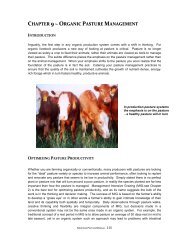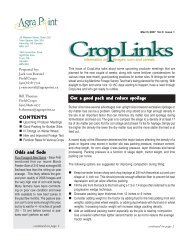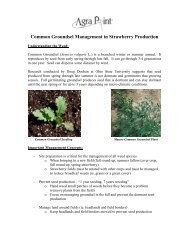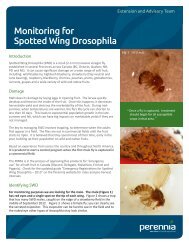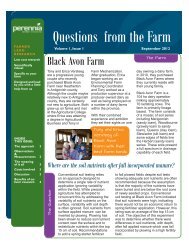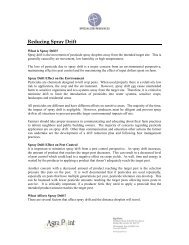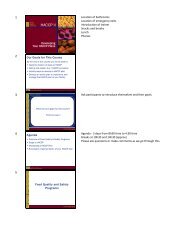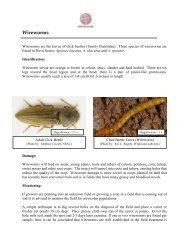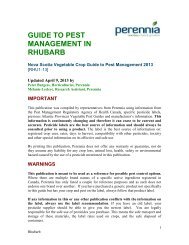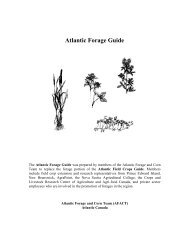Goldenrod Management in Wild Blueberry - Perennia
Goldenrod Management in Wild Blueberry - Perennia
Goldenrod Management in Wild Blueberry - Perennia
Create successful ePaper yourself
Turn your PDF publications into a flip-book with our unique Google optimized e-Paper software.
<strong>Goldenrod</strong> <strong>Management</strong> <strong>in</strong> <strong>Wild</strong> <strong>Blueberry</strong><br />
Description<br />
Several goldenrod species occur<br />
<strong>in</strong> wild blueberry fields. All are<br />
herbaceous perennials that<br />
reproduce by seed and<br />
underground stems called<br />
rhizomes. Expansion of<br />
goldenrods occurs ma<strong>in</strong>ly by<br />
growth and expansion of<br />
rhizomes, result<strong>in</strong>g <strong>in</strong> dense<br />
patches that are especially<br />
common <strong>in</strong> wet areas and bare<br />
spots. <strong>Goldenrod</strong>s are aggressive<br />
weeds that can reduce yield<br />
potential and h<strong>in</strong>der harvest. The<br />
most common weedy species <strong>in</strong><br />
blueberry fields are Canada<br />
goldenrod (Solidago canadensis<br />
L.), narrow-leaved goldenrod<br />
(Euthamia gram<strong>in</strong>ifolia (L.) Nutt.<br />
ex. Cass.), and rough goldenrod<br />
(Solidago rugosa Ait.).<br />
<strong>Management</strong><br />
The expected pattern of carbohydrate movement <strong>in</strong> goldenrods at specific growth stages is expla<strong>in</strong>ed <strong>in</strong> the<br />
figure at the end of the factsheet. The arrows <strong>in</strong>dicate the direction of carbohydrate movement from the<br />
rhizomes to the develop<strong>in</strong>g shoots (↑) or from developed shoots back to rhizomes (↓). The red color illustrates<br />
potential w<strong>in</strong>dows of opportunity for control. Effective management depends upon proper tim<strong>in</strong>g.<br />
Physical Control. There are limited physical control options for goldenrods <strong>in</strong> blueberry fields due to the<br />
perennial nature of the weed and the crop. Biannual mow<strong>in</strong>g is not an effective management technique and<br />
goldenrod shoot density may <strong>in</strong>crease follow<strong>in</strong>g prun<strong>in</strong>g. Shoots taller than the blueberry canopy can be handpulled<br />
or mowed. Physical control of goldenrods is most effective when conducted before developed shoots<br />
beg<strong>in</strong> to replenish rhizome food reserves. This generally occurs when the shoots reach one third of the total<br />
expected height. Repeated pull<strong>in</strong>g or clipp<strong>in</strong>g will be necessary to deplete food reserves <strong>in</strong> rhizomes and it will<br />
take several years to obta<strong>in</strong> adequate suppression. Crop year prun<strong>in</strong>g of goldenrods just above the canopy 2-3<br />
weeks prior to harvest will enhance harvest efficiency and prevent seed production.
Broadcast Herbicide Applications. Velpar®<br />
(hexaz<strong>in</strong>one) and Callisto® (mesotrione) can be<br />
applied as broadcast applications to control<br />
goldenrods <strong>in</strong> blueberry fields. Velpar® is applied as a<br />
pre-emergent product (before weeds emerge) <strong>in</strong> the<br />
spr<strong>in</strong>g of the prune year and is activated <strong>in</strong> the soil by<br />
ra<strong>in</strong>fall. Sprout year applications of Velpar® will<br />
reduce goldenrod density <strong>in</strong> both the sprout and crop<br />
year. Most goldenrod species are still sensitive to<br />
Velpar® though complete control is rarely achieved.<br />
Callisto® is generally applied as a post-emergent<br />
product (after weeds emerge) and can only be applied<br />
<strong>in</strong> sprout year wild blueberry fields. Callisto® should<br />
be applied when goldenrods are at least 10cm tall but<br />
before flowers fully open. <strong>Goldenrod</strong>s may reestablish<br />
if Callisto is applied when the shoots are<br />
very small (less than 10 cm tall). Tim<strong>in</strong>g can vary<br />
depend<strong>in</strong>g on year, but applications are generally<br />
made by mid-June. Plants will turn white and beg<strong>in</strong> to<br />
die with<strong>in</strong> 1-2 weeks after application. Callisto® can<br />
also be applied as a pre-emergent product (before<br />
weeds emerge), but results from research trials have<br />
been less satisfactory when compared to postemergence<br />
applications. Callisto® is most effective<br />
when it follows a Velpar® application<br />
Spot and Wiper Herbicide Applications. Several herbicides conta<strong>in</strong><strong>in</strong>g the active <strong>in</strong>gredient glyphosate are<br />
registered for weed control <strong>in</strong> blueberry fields. Glyphosate products are generally applied as directed (spot)<br />
applications or with selective roller/wiper applicators to treat weed growth above blueberry plants. <strong>Goldenrod</strong>s<br />
should be treated when food reserves are be<strong>in</strong>g translocated to rhizomes, either just before flower bud formation<br />
or after seed set. The w<strong>in</strong>dow for applications after seed set is smaller <strong>in</strong> the fall as foliage does not tolerate<br />
kill<strong>in</strong>g frosts.
Growth stage and expected carbohydrate movement <strong>in</strong> weedy goldenrod species <strong>in</strong> wild blueberry fields<br />
Prepared by:<br />
Nathan Boyd and Scott White, Vegetation <strong>Management</strong> Research Program, NSAC<br />
Peter Burgess, AgraPo<strong>in</strong>t<br />
Photos obta<strong>in</strong>ed from VMRP and AAFC<br />
June 30, 2009



